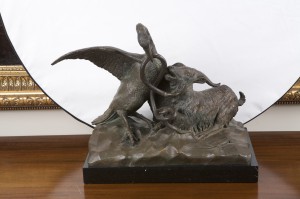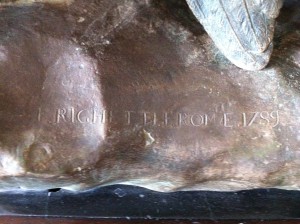F.Righetti ,1749-1819,(signed and 1789.)

 Francesco Righetti the Elder
Francesco Righetti the Elder
Italian, 1749 — 1819
View Objects By Francesco Righetti the Elder >>
As a sculptor, silversmith, and bronze founder, Francesco Righetti worked on large-scale projects for popes and monarchs: he is best remembered, however, for his small bronze statuettes after famous antiquities. Righetti trained in the workshop of the leading Roman sculptor-silversmith of the day, Luigi Valadier, and emerged from his training as a versatile artist-craftsman in his own right. Righetti’s first major independent commission came in 1781, from the English banker Henry Hope. Hope requested twelve full-sized lead replicas of famous sculptures, which were to be painted white to simulate marble. The group, intended to decorate a country home, included not only copies of antiquities but also of works by Giambologna and Duquesnoy. Righetti’s refined metalwork soon attracted the highest level of patronage. For the famous Grand Tourist Frederick Hervey, Bishop of Derry and EarI of Bristol, Righetti fashioned two bronze candlesticks, the design of which incorporated antique figures. In 1786 Catherine the Great of Russia commissioned Righetti to create a marble model of Mount Parnassus, which he populated with bronze statuettes of Apollo, the Muses, and the winged horse Pegasus. With the exception of Pegasus, the figures were all reduced-scale versions of a celebrated statuary group in the Vatican’s Museo Pio-Clementino. To such connoisseurs as the empress and her agents, the imitative nature of such art enhanced rather than detracted from the value of the bronzes: the admiration of such specifically identifiable antiquities as the Vatican Muses was a signal of taste and cultivation. The rearrangement of the miniatures, whether on a specially commissioned marble Parnassus or on the chimneypiece of an aristocratic studio, was a further exercise in cultivation.
During the 1780s Righetti established himself as a producer of bronze miniatures after famous antique prototypes, a genre of sculpture that developed in the second half of the eighteenth century in response to the burgeoning art market. While such bronzes had enjoyed popularity among Italian collectors and connoisseurs for two centuries, they held particular appeal to the Grand Tour market. The vogue for such objects can be attributed in part to the spiraling prices of real antiquities in the eighteenth century. This, combined with tightening papal control over the excavation and export of archeological material, placed the acquisition of choice artifacts beyond all but the very wealthiest collectors. Artists such as Righetti and his competition Giovanni and Giacomo Zoffoli obliged and fed demand for the bronze miniatures, while other artists did similar work in terracotta or biscuit porcelain.
Like any metal-casting project, Righetti’s enterprise was collaborative. Aside from maintaining a workshop staff that included his son Luigi, Righetti is known to have employed other artists to sculpt for him. Documentary sources indicate, for instance, that the sculptor Camillo Pacetti copied antiquities for Righetti in 1785.
In 1794 Righetti published a catalogue-style price list of the miniature statues available from his workshop, a document that attests both to the scope of his production and to his promotional talent. The offerings included seventy-eight single figures, twenty-five figure groups, forty-six busts, and various vases, trophies, and animal sculptures. Although most of the advertised bronzes were after noted antiquities, the catalogue also lists copies of modern works, including four statuettes after Bernini and five after Giambologna. In the same document the sculptor expressed his willingness to do custom work, offering to copy statues of the buyer’s choice either in miniature or in full scale. Significantly, the 1794 price list is written in French, suggesting that Righetti conceived the miniatures for a foreign clientele.
In 1801 the newly elected Pope Pius VII paid Righetti the unusual honor of visiting the artist in his workshop. Admiring his work, the pope commissioned a gilt bronze set of altar furnishings as a gift for the church of S. Giorgio Maggiore in Venice. Two years later Righetti created a pair of miniature obelisks commemorating the marriage of Prince Camillo Borghese to Paolina Bonaparte, the sister of Pius VII’s nemesis, Napoleon. That same year, almost certainly at the commission of the king of Naples, Righetti and his son produced a set of Apollo and the Muses (Capodimonte, Naples) that recalls the Parnassus group carried out seventeen years before for Catherine the Great. Again the models were the Vatican statues, although instead of the marble mountain, four classicizing architectonic bases provide the ambient for the bronze figures. The king later commissioned Righetti to make a set of altar furnishings for his great votive church in Naples, S. Francesco di Paola.
While Righetti’s copies of antique statuary reflect the artist’s desire for faithful reproduction, his decorative work shows another side of his personality. In vases, candelabra, tripods, and other projects Righetti drew from the influence of his teacher Valadier and from the capricious eclecticism of Giovanni Battista Piranesi. In his more flamboyant works Righetti mingled exoticizing Egyptian sources, classical motifs, and vegetal forms, treating all with an imaginative sense of grotesquerie.
Righetti also worked on the casting of large-scale bronzes, and in 1805 Pope Pius VII appointed the artist to succeed Giuseppe Valadier as director of the Vatican foundry. In 1809, in his capacity as a bronze founder, Righetti collaborated with Antonio Canova to produce the giant bronze figure of Napoleon (Brera, Milan) for Prince Eugène de Beauharnais, the French viceroy of Italy. In 1819 Righetti and his son Luigi cast Canova’s monumental equestrian Charles III, which still stands before the royal palace in Naples. After Righetti’s death later that year, the family enterprises in Naples and Rome continued under the direction of his son Luigi Righetti and grandson Francesco Righetti the Younger. The works of the family, highly prized and for the most part easily portable, are distributed in some of the most important European and American collections.